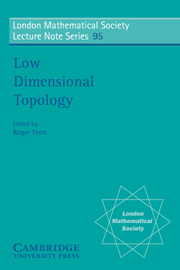Book contents
- Frontmatter
- Contents
- List of participants
- Noeuds rigidement inversables
- The classification of Seifert fibred 3-orbifolds
- Exchangeable braids
- Nilpotent coverings of links and Milnor's invariant
- Presentation en ponts des noeuds rationelles
- Piecewise linear I-equivalence of links
- Some closed incompressible surfaces in knot complements which survive surgery
- Simple elements of π2(M3, x0)
- A note on the mapping class group of surfaces and planar discontinuous groups
- ‘Zur Klassifikation höherdimensionaler Seifertscher Faserräume’
- Problem list
The classification of Seifert fibred 3-orbifolds
Published online by Cambridge University Press: 04 May 2010
- Frontmatter
- Contents
- List of participants
- Noeuds rigidement inversables
- The classification of Seifert fibred 3-orbifolds
- Exchangeable braids
- Nilpotent coverings of links and Milnor's invariant
- Presentation en ponts des noeuds rationelles
- Piecewise linear I-equivalence of links
- Some closed incompressible surfaces in knot complements which survive surgery
- Simple elements of π2(M3, x0)
- A note on the mapping class group of surfaces and planar discontinuous groups
- ‘Zur Klassifikation höherdimensionaler Seifertscher Faserräume’
- Problem list
Summary
With surprising frequency there occurs an object of the following type: a metrizable 3-manifold (with possibly some isolated interior singularities) equipped with suitably well-behaved or ‘tame’ decomposition into circles and (compact) intervals. Those tame decompositions involving circles only, where in addition the manifold is orientable near each circle, are precisely the well-studied Seifertfibrations of 3-manifolds, (Seifert, H., 1932; Orlik, P., 1972; Siebenmann, L.C., 1978). Tame decompositions involving intervals have been studied far less, but they are by no means rare. They occur in many quotient spaces of classical crystallographic groups (139 out of 219)*, and also for many non-classical crystallographic groups; see Bonahon, F. ε Siebenmann, L.C. (to appear); Dunbar, W.D. (1983); Seifert, H. ε Threlfall, W. (1930 ε 1932). We have encountered them in our study of classical knots (Bonahon, F. ε Siebenmann, L.C, to appear), through the so-called Montesinos and arborescent knots (that include respectively 174 and 208 of the 250 ten crossing knots). We will mention these examples further when we have clear definitions in hand.
The purpose of this article is to give an elementary and complete classification of all ‘tame’ decompositions in dimension 3 into circles and intervals, thus extending Herbert Seifert's 1932 classification of what have since been called Seifert fibrations.
The classification of tame decompositions for which the ambient space is oriented is widely known and has been touched on by several authors following Montesinos' stimulating descriptions in the early 1970's, cf. Montesinos, J.-M. (1980); Thurston, W.P. (1976-79); Dunbar, W.D. (1981); Zieschang, H. ε Zimmerman, B. (1982).
- Type
- Chapter
- Information
- Low Dimensional Topology , pp. 19 - 85Publisher: Cambridge University PressPrint publication year: 1985
- 25
- Cited by

